Christmas in Europe
Christmas is a holiday commemorating the birth of Jesus Christ. It is celebrated by Christians but also by many non-Christians. Christmas is a festival of peace, love and understanding. Despite becoming more and more commercialized, many of traditions are still being observed.
People of Island can not imagine their Christmas without the Yule lads or "jólasveinar". These 13 Yule lads are trolls. They live in a cave located high up in mountains. Lads live together with their mother "Grýla", father "Leppalúði" and black cat "Yuletide". Grýla has been having quite a life. She has some 80 children with 3 different husbands. Nobody knows what happened to the first husband. But it is known that she ate the second one. According to local mythology she is constantly wandering in search of naughty children. She takes them to her cave. There they finish as part of her stew.
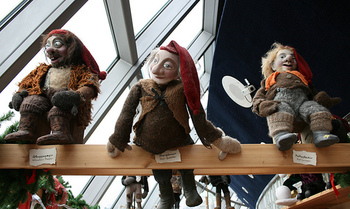 Yule lads or jólasveinar
Yule lads or jólasveinar
Icelandic kids put their shoes in a window for 13 days before Christmas. If they have been good they find some sweets or fruits in their shoes. But if they have been bad they find a potato or a fish bone. Yule lads are always arriving in a specific order. The first lad who arrives is "Stekkjarstaur". He tries to drink milk from sheep he finds. This is not an easy task because of his stiff legs. The 13th lad "Kertasníkir" arrives in town on the 24th December. He is known for his appetite for candles. In the past candles were made of animal fat. So, Kertasníkir believes that candles he eats will keep him warm on his way back home.
On Christmas Eve all 13 Yule lads are among humans. From the 25th December until 6th January lads are returning to their cave. The first one who returns is the one who arrived first. On Christmas everyone in Island has to get some new cloth. It is believed that the cat Yuletide will attack all those who do not get it.
Norwegians believe that on Christmas Eve witches and other evil spirits have a party. So, people try to hide all of their brooms to prevent the party. "Nise" is also part of Christmas in Norway. He is a goat-like gnome. He is also known as the Christmas Buck or "Julebukk" in Norwegian. Kids in Norway get a bowl of special porridge which they keep ready for Nisse. Without this porridge Nisse will make pranks with kids.
One of the most famous Christmas songs in Norway is "Musevisa" or "The Mouse Song". The lyrics for this song were written in 1946 by Alf Prøysen. The song is about mice family getting ready for Christmas. Mother and Fater mice are warning their kids to be careful because of mouse traps. An old Norwegian folk tune was used as tune in Musevisa.
Saint Lucia Day, on the 13th December, marks the start of Christmas celebrations in Sweden. The eldest female child in a family gets dressed in white and has a crown with numerous candles. During family party she then gives her parents special buns called "Lussekatts" and some coffee or "Glögg" (mulled wine).
Christmas is the time when the Swedes drink lot of Julmust (in Swedish Jul is Christmas and must is a juice). When drank at Easter the drink is called Påskmust (in Swedish Påsk is Easter). It is not that common but in other parts of year this non-alcoholic drink is available as must. Julmust contains malt and hop extracts, various spices, carbonated water etc.
On Christmas Eve some places in Sweden organize processions with lit candles to a local church. As one of Christmas delicacies people prepare "Risgryngrot". It is a rice porridge. An almond is put inside. The person who finds it gets so called almond present. This tradition exists in Sweden, Denmark, Norway and Iceland. There is also a belief that whoever finds the almond has to make a wish or will get married in the coming year.
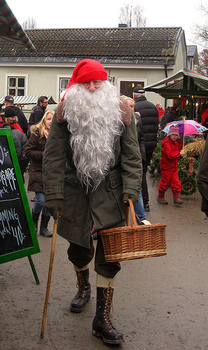 Tomte or Jultomte
Tomte or Jultomte
After Christmas dinner one family member gets dressed as gnome "Tomte" or "Jultomte". He/she gives presents to other family members. It is believed that these gnomes live under floor boards and ride a goat called "Julbocker". Typical Swedish Christmas tree decoration is a small goat made of straw. Christmas time in Sweden ends on Hilarymas or Saint Knut's Day, which is on the 13th January. Big parties are held. Traditionally people then throw Christmas trees out of their homes.
In Denmark people have a special candle. They call it the calendar candle. It has 24 markings. It is decorated with firs or little pixies. The candle is lit every day from the 1st December until Christmas Eve. This tradition was started in the 1930's.
Danish kids have their personal Christmas calendars. The first day in the calendar is the 1st of December. Some calendars are built with pockets where people put sweets. Kid's calendars can be bought in post offices or banks. The first calendar of this kind appeared in 1932. Already mentioned pockets were introduced after the World War 2. The money from the sale of kid's calendars goes to poor children in other countries.
Denmark is famous for its Christmas seals used on letters and postcards. The first of these special seals was used in 1904. Seals are designed by famous artists and the Danish Queen Margrethe II. According to an old tradition some farmers in Denmark feed their animals especially well. It is believed that on the Christmas Eve animals can talk. So, it would not be nice to hear bad words on this special night. Similar tradition includes bringing little bit of food in forests and parks.
The Danes have two days called Christmas Eve. The first one is on the 23th December. It is known as the little Christmas Eve. On that day people eat special doughnuts called "Æbleskiver". Some "Gløgg" is drank. On the 24th December people enjoy the Christmas dinner, exchange of presents, dancing around the Christmas tree and singing of traditional Christmas carols.
On Christmas Eve people in Finland attend a mass and go to sauna. On Christmas some people traditionally put lit candles on the graves of their dead family members. Quite similar to the above mentioned porridge eaten by Swedes, Finns also have Christmas porridge of their own. The person who finds an almond inside his or her bowl of porridge has to sing a song. In some parts of the country there are so called "Star Boys" who go from house to house singing Christmas carols.
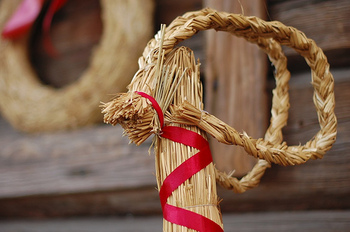 Joulupukki or Yule Goat
Joulupukki or Yule Goat
The traditional Finnish Christmas character is "Joulupukki" or "Yule Goat". There is an old myth describing him as an old man dressed in a goat costume. He was ugly and used to frighten kids. It is not completely clear how this creature was transformed to a good old man known all over the world as Santa. Joulupukki has a wife called "Joulumuori" ("Old Lady Christmas"). Joulupukki lives in Korvatunturi located in the Finnish Lapland region. He travels in a sleigh pulled by several reindeers. When Joulupukki arrives to a certain home he first says "Onkos täällä kilttejä lapsia?" or in English "Are there any well-behaved children here?"
In Latvia Christmas is a combination of celebrating Christ's birthday and the rebirth of the Sun maiden. In Latvia Christmas presents are brought by "Ziemmassve'tku veci'tis". He brings presents on all 12 days of Christmas season. During Christmas Latvians decorate their rooms with straw or reed ornaments called lukturi, puzuri, krigi, putni etc. The most famous Latvian Christmas tradition is called "mumming". Group of people lead by so called "father" wear costumes and masks - bears, horses, goats, living corpses, haystacks etc. They go from village to village. Their arrival is seen as blessing. Christmas is also time for the dragging and burning of Yule log. This log is symbol of all problems in the past year.
On Christmas Eve in Lithuania people set an extra plate for a family member that was not able to come or has died in the past year. The meal served on Christmas Eve includes 12 dishes, one for each apostle. Some of these dishes are beet soup, dumplings filled with mushrooms, herrings etc.
After dinner girls old enough to get married go outside and bring some kindling wood. Even number of kindling shows that there will be a marriage in the coming year. Straw of different length is put under the tablecloth. It is drawn out by family members. It is believed that the length of one's life can be predicted that way. Christmas tree in Lithuania is traditionally decorated with ornaments made of wheat or rye straw.
Russians celebrate Christmas on the 7th January. It is done so according to the old Julian calendar. People fast on Christmas Eve. They usually fast until evening religious worship or until the first star appear. A typical dish served at the Christmas eve meal or "Holy Supper" is a porridge called "Kutya". Its ingredients have symbolic meaning. Different grains symbolize hope. Honey and poppy seeds symbolize joy and peace. Similar to already mentioned Lithuanian tradition Russians also have 12 dishes, one for each apostle. Examples of these dishes are grated garlic, bowl of honey, nuts, peas etc.
"Kolyadki" are yet another Russian Christmas tradition. They were named after Pagan solar goddess Kolyada who actually made winter days longer. Kolyadki are the group of man wearing masks. They sing. For their music people give them money and food. Christmas tree or "yolka" was brought to Russia by its emperor Peter the Great in the 1700's.
Christmas Eve in Ukraine is the time when people make "Vertep" (cave in Ancient Greek). Vertep can be described as kind of a play. People dressed in various costumes and go from house to house. Through their performance they try to show the true meaning of Christmas. Everyday issues are also presented.
In parts of western Ukraine people make "Didukh". Didukh is a sheaf made of wheat or oat. Its shape is quite unique. It has four legs and many bundles. Didukh symbolizes prosperous coming year.
People of Belarus have lovely Christmas traditions too. Different games are played. Single woman tries to put two mirrors together. It is believed that, if done properly, a face of future husband can be seen in one of them. Fortune-telling is a topic of the next game too. Each of single women in the group takes a pile of corn in her hands. Rooster is brought and left to wander. The woman whose corn rooster starts to eat is going to get married first.
During Advent Polish people prepare a honey cake called "piernik". Piernik can be of different shape - animals, hearts, Saint Nicholas etc. In Poland there is also a tradition of making "oplatek". Oplatek is a bread with a picture of Mary, Joseph and Jesus on it. Family members get around the table. Everyone takes a piece and eat it. A little peace of oplatek is sometimes given to farm animals or pets. Those who share the bread forgive all the bad things happened in the past year and wish all the best to others.
Traditional Polish Christmas decorations are called “pająki” (“spiders”). They are made of straw, paper and eggshells. They are usually placed on a ceiling as lovely chandeliers. They were symbols of fertility and good luck in the coming year.
Traditional nativity scene from Kraków, Poland is known as Kraków szopka (in Polish - Szopka krakowska). Their making started in the 19th century. On the first Thursday in December there is a competition for the most beautiful nativity scene. The first one was organized in 1937. There were no competitions during World War 2.
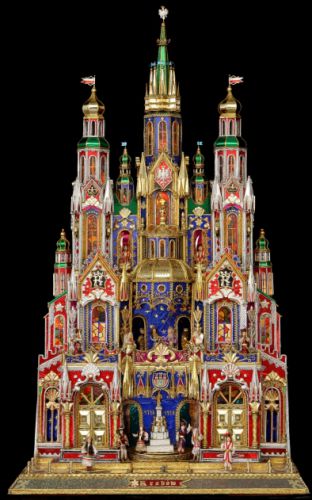 Kraków szopka (photo by Rafał Korzeniowski)
Kraków szopka (photo by Rafał Korzeniowski)
The nativity scenes are first shown at the Main Square. Later they are brought to the City Historical Museum where the jury decides about the winner. The most beautiful nativity scenes are kept there until February.
People of Czech Republic have a tradition called "Barboky". On the 4th December it is the feast of Saint Barbara (Barbora in Czech). On that day a single woman goes to an orchard. There she cuts off a twig of a cherry tree. She brings the twig to her home and puts it in water. If it blooms until Christmas Eve the girl is going to get married within a year.
There is yet another similar Czech tradition. It is rather simple. Single woman takes a shoe and stands with her back facing door. She then throws a shoe over her shoulder. If a toe of her shoe is facing towards the door she is going to leave the house and get married. But if a heel is pointing towards door she is going to stay at home and continue being single.
Everyone present at Christmas dinner gets an apple. He or she cuts in half, crosswise, across the stem. All those who can see a five-pointed star in the core of their apple can expect lot of happiness in the coming year. Those with four-pointed core will get ill. The worst possible situation is cross-shaped core. Person holding such an apple can expect death.
In a way similar tradition is played with walnuts. Person who finds a healthy core in four walnuts will experience a year of good health. Walnut shells are used for making little boats. Inside each shell tiny candle is put and then lit. Person puts his or her boat in a bowl full of water. If the boat sails for long time its owner can expect a long life.
The same as in other European countries, Christmas in Slovakia includes combination of Christianity and traditions of Pagan origin. On the 30 November, which is Saint Andrew Day, Slovaks make traditional dumplings called "Halušky".
Single woman writes names of men on little pieces of paper. She then sticks them into parts of dough used in the preparation of dumplings. People traditionally fast on Christmas Eve. It is believed that those manage to do it will after the Midnight Mass see a golden pig.
A table at Christmas dinner is a bit strange. The floor under it is painted with white lime. Table legs are chained as symbol of family unity. As protection from evil mother traditionally uses little bit of honey and makes cross on the forehead of each family member. All of them then dip a piece of special Christmas waffle in honey and eat it together with garlic. Honey is used for a person to become good, healthy as bee. Garlic protects against evil spirits.
Hungarians make a rather special wooden chair. People start to make it on the 13th December, which is Saint Lucia Day or as locals would say Luca's Day. The chair has to be finished until Christmas Eve. It is quite slow. If something in life is very slow, Hungarians say that it is being made slower than the Luca's chair. Real purpose of this chair can be seen at the mass during Holy Night. A person who steps on it will be able to see witches. As soon as he/she sees them he/she has to run towards his/her home. Witches will chase him/her. But this can be stopped by dropping some poppy seeds or millet. Witches will have to stop to collect them and the person will have time to reach his/her home.
There are many more traditions related to Saint Lucia Day. A person who does not spend money on this day will be rich in the coming year. If someone gives him/her money it means good luck. Sometime before Christmas Hungarian children write "Jézuska" or letters to baby Jesus in which they express their wishes for Christmas. They put this letters close to window for special angels to find them.
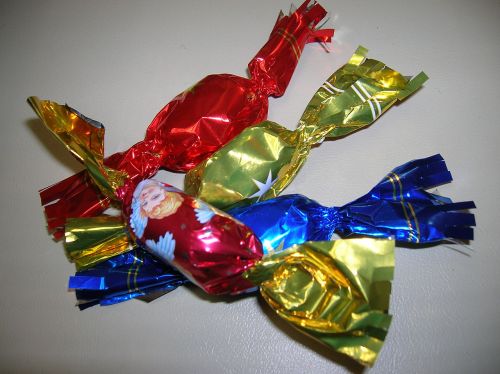 Szaloncukor
Szaloncukor
One of the most popular Christmas tree ornaments in Hungary is "Szaloncukor". It is a chocolate covered candy with different fillings (marzipan, raspberry, orange etc.). This candy is wrapped in nice foil of different colours (gold, red, blue etc.). Two days after Christmas Hungarians observe a tradition called "borszentelés" or "blessing the wine". Wine is brought to church for a priest to bless it. It is believed that such wine has special powers, to heal a sick person for example.
The ritual pig slaughtering called "Ignatius" is a very popular event in Romania. It is held on the 20th December, which is Saint Ignatius Day. This sort of funeral, among other things, includes incensing the pig by wife, blessing the pig with a sign of cross by husband. Apart from eating pork people drink lot of wine and plum brandy. In parts of Romania people organize "capra" or "brezaia". People wearing goat costume dance from door to door. Flute music is performed.
In Bulgaria people have "budnik". The word budnik comes from "budeshte" which is future in Bulgarian. The budnik is a mythical tree with roots deep in the ground and with branches touching the sky. Leaves on this tree are made of gold and silver. This tree is mentioned in Bulgarian Christmas carols. It is believed that on Christmas Christ arrives down this tree. He brings good fortune for everyone in the family.
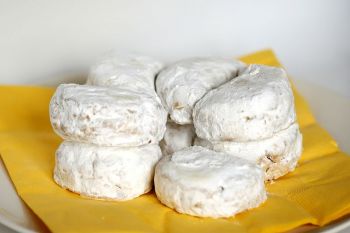 Kourabiedes
Kourabiedes
In Greece people love their Kourabiedes cookies. They are made with almonds. Some Metaxa brandy or rose water can be added as an extra ingredient. Melomakarona cookies are very popular too. Their main ingredients are orange, cinnamon and honey. Greeks have something what they call "Kallikantzaroi". They are evil creatures who arrive to people's homes during Christmas holidays. Nobody is sure about their appearance. Some say that they wear metal shoes. How to prevent them from coming to your home? It is easy. Just put a pig jaw inside the chimney.
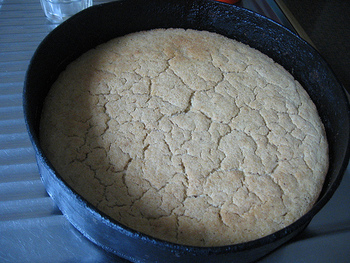 Česnica bread
Česnica bread
In Serbia people start preparing of "Česnica" in the early hours of Christmas, which is there on the 7th January. Word "česnica" comes from "čest" which in Serbian means part. Česnica is a special bread shared by family members. Inside bread there is a coin hidden. Whoever finds it will be happy during whole year.
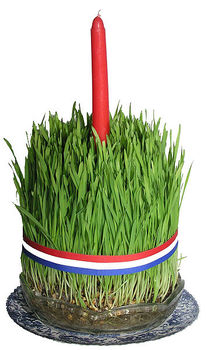 Božićna pšenica or Christmas wheat
Božićna pšenica or Christmas wheat
People in Croatia have "božićna pšenica" or "Christmas wheat". On Saint Lucia Day, which is on the 13th December, people put some wheat grain on a plate covered with little bit of soil. If kept in proper conditions and watered regularly until Christmas Eve small green bush will grow. Around it people tie a stripe with Croatian flag. In center of bush a candle is often put. Christmas wheat symbolizes wishes for prosperous coming year in both family and nation.
On Christmas Eve people of the Italian town of Agnone, Molise organize Ndocciata. It is an impressive parade where hundreds of people carry “ndocce” (torches). Each “ndocca” has fanwise shape. It consists of one or up to 20 torches. It is between 3 and 4 metres high. The event also includes local singers and bagpipers. The parade ends at the Plebiscite Square with the performance of bonfire known as the “Bonfire of Brotherhood”.
One of the oldest Italian Christmas traditions is "La Befana". Every 6th January kids in Italy hope that La Befana will visit their home. La Befana has her own legend. Three Wise Men or Magi have been searching for the Baby Jesus. They got lost so they decided to stop and ask for the direction in a small house. An old woman opened the door. Unfortunately she could not help them. They asked her to join them on their journey. But she said that she is far to busy.
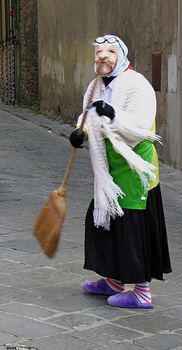 La Befana
La Befana
After they left she began to feel guilty. So she decided to go and find them. She had been trying but without success. Then she started giving little presents to every child she met in hope that he is the Baby Jesus. That is how the tradition was created. Each eve of the Epiphany La Befana is going from house to house leaving presents for good kids. All those bad ones get a piece of coal.
People of Italy also have a "Ceppo". Ceppo has two different meanings. For some it is a log burned in the fireplace during Christmas season. Such a log has purification meaning. It somehow cleanse all the bad things in passing year. There are also Italians for whom the Ceppo is a wooden object of pyramid shape. This tradition was started in the Italian region of Tuscany. Such Ceppo has three or four shelves and wooden frame decorated with some special paper. On the bottom shelf family puts its nativity scene or "Prespio". On other shelves people usually put some decorative foliage, fruits and presents.
Nativity scene or Christmas crib was first made in 1223 by Saint Francis of Assisi. Its appearance is based on the way the birth of Jesus Christ is described in the Gospel of Matthew and the Gospel of Luke. Such a scene can be presented in the form of picture, but it is much more popular as one with live characters or figures made of wood, clay, straw or other materials. Each nativity scene includes baby Jesus, his mother Mary, and Mary's husband Joseph. Many nativity scenes also include some other characters from the Biblical story like shepherds, the Magi and angels. Nativity scene is now part of Christmas in many nations all over the World. Christmas cribs are usually set on the 8th December, which is the Feast of the Immaculate Conception. Figure of baby Jesus is put on the evening of the 24th December.
Little bit of nativity scene trivia. The largest mechanical nativity scene is the Czech one. It is called "Krýzovy" nativity scene. It was made by Tomáš Krýza (1838-1918) out of wood, fabric and leather. He needed 60 years to complete it. It includes 13 sets of figures. 130 figures are mobile. This nativity scene can be seen in the museum of Jindřichův Hradec. Jindřichův Hradec is a small town in the South Bohemian Region of the Czech Republic. The best place to see and/or buy cribs is Via San Gregorio Armeno. It is a street in Naples, Italy.
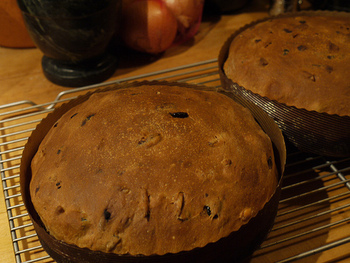 Panettone
Panettone
Back to Italy and its Christmas. No Christmas in Italy can be described without "Panettone". Panettone is a sweet bread originated in Italian city of Milan. The word "panettone" comes from the Italian word "panetto" which means a small loaf of bread. This cupola shaped delicacy includes candied orange, lemon zest, raisins and other ingredients. In parts of Italy it is eaten with famous Crema di Mascarpone.
In Malta people have a Christmas tradition called the "Priedka tat-Tifel" or the "preaching of the child". A child, aged between 7 and 10, is chosen to preach the sermon at the midnight mass. A boy or a girl starts preparations four or five weeks before the mass.
Christmas traditions in Spain differ from region to region. In Catalonia people hollow out a log. Then they decorate it for the log to have something like hands and face. Usually the newly created creature looks like dog or reindeer. On the 8th December people start "feeding" the creature by putting candies and toys in the log. The log should be full until Christmas. What follows is beating the log or "Caga Tio" for the creature to "poop" out everything what is inside the log. Catalan people even have a song about it. In English it goes something like this "“Poop log, poop turron, hazelnuts and cottage cheese, if you don’t poop well, I’ll hit you with a stick, poop log!” By the way, turron is an almond Christmas candy.
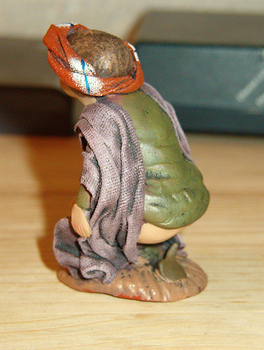 Caganer
Caganer
"Caganer" is a figurine showing a peasant wearing a traditional Catalan hat "barretina". Word caganer in Catalan means a "pooper". The figurine shows a man excreting. Similar figurines exist in other parts of Spain (Salamanca, Murcia), Portugal, southern France and Italy (Naples). Caganer is not always a peasant. Figurines showing politicians, persons from show business and even royalty can be bought. Caganer has a symbolic meaning. It represents abundant harvest in the coming year. The Caganer figurine is kept as part of nativity scene. But it is positioned little bit away from other figurines. This is done to avoid other figurines to get dirty by Caganer's poo.
Many people in Spain attend the Midnight Mass. People call it "La Misa Del Gallo" or the Mass of the Rooster. It is believed that a rooster crowed when Jesus Christ was born. On the 28th December it is "Día de los santos inocentes" or "Holy Innocents' Day". In Spain this day is traditionally celebrated as sort of April Fools' Day. People try to cheat each other by telling silly stories and jokes. TV and newspapers also present similar stuff. If the other person believes in your little joke you can call him "inocente, inocente" or in English "innocent, innocent".
Apart on Christmas, kids in Spain get presents by the Magi. There is a tradition known as the Cavalcade of Magi. It exists in all Spanish cities. This parade includes coaches with Magi and their assistants who throw candies to kids.
Also on the 5th January, kids traditionally put their clean shoes under beds expecting presents they asked for in their letters. Naughty kids get the Carbón Dulce (Candy Coal). They find them on the 6th January. On Epiphany or "Dia de Tres Reyes", people of Andalucia prepare special ring shape biscuit called the “Roscon de los Reyes". Inside the cake there is a surprise. Whoever finds it is declared king or queen of the family.
Christmas celebrations in the Basque country start with the Saint Thomas' Day on the 21st December. Streets are full of people dancing. They wear the casera traditional folk costumes. There is lot of food available. The most popular delicacy is certainly the txistorra sausage.
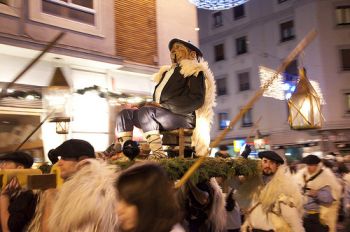 Olentzero
Olentzero
Basque Christmas can not be imagined without the Olentzero. On Christmas Eve the figure of Olentzero sitting on a chair is carried along every street. The people accompanying the statue often stop and sing Christmas carols.
There are some regional differences. For example, in the autonomous community of Nafarroa (in Spanish Navarra) it is believed that Olentzero is coming from mountains. He brings chestnuts and wine, but also some presents for the kids. Olentzero can appear as a shepherd, farm worker or coal man. He is always the messenger of good news.
"Consoda" is held on the Christmas morning in Portugal. People set an extra place on the table. This place is meant for the souls of the dead. By putting little bit of food for souls people expect fortunate coming year. Traditional Portuguese Christmas delicacy is "Bolo Rei". It is a fruit cake containing two surprises. The first one is a fake ring, tiny doll or a medal. The second surprise hidden in the cake is a raw broad bean. The person who gets the bean has to buy the cake next year. Similar to Spain Portuguese kids also get presents by the Magi. To attract horses on which they ride kids fill their shoes with some carrots and straw.
The nativity scene in the French village of Grignan located in the region of Provence is really amazing. It can be seen from early November until late February. There are more than 80 houses made of stone, wood and cement. Their roofs are covered with 60,000 tiles. This nativity scene includes more than 1,000 human and animal figurines. Most figurines are about 30 centimetres high. The nativity figurines were made by Lise Berger.
In France there is a tradition of leaving candle burning in case that Virgin Mary passes by. France has one of the richest cuisines in the world. So it is rather difficult to describe all the delicacies prepared for the occasion. Probably the highlight of French Christmas is a meal called "le Réveillon" (from the verb réveiller which means to wake up or revive). People have this meal after coming back from "la Messe de Minuit" in a local church. In southern France people prepare "Le pain calendeau" or Christmas loaf. It is cut crosswise and one part of it has to be given to a poor person. One of the most famous French Christmas cakes is "Buche de Noel" or "Christmas Log" which is made of chocolate and chestnuts.
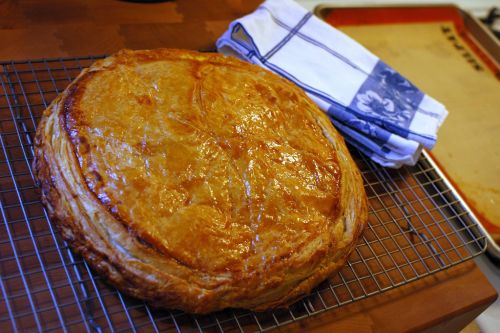 Galette des Rois
Galette des Rois
The Epiphany or in French "Fête des Rois" is often celebrated by making "Galette des Rois" or "Kings' cake". It is an almond cake which has a figurine or “la fève” hidden inside of it. La fève was originally a broad bean ("fève”). Since 1870 people have been using porcelain or plastic figurines. Nowadays people usually put figurines of music and film stars, works of art etc. The one who finds a figurine will become king or queen of the day and is going to provide the cake next year. He or she is crowned with a paper crown.
Similar to France, families in Ireland traditionally light a candle in their window. It is a sign of welcome for Mary and Joseph. According to tradition this candle should be lit by the youngest kid in family. If possible, such a candle is then put in the window by a girl called Mary. In some Irish villages people still observe tradition of "whitewashing". They clean and paint all buildings at the farm with white paint or limewash. Local merchants paint the outside of their shops.
After Christmas Eve meal Irish people set the table again. This is called the Laden table. On such a table people put bread with caraway seeds and raisins, some milk and a big lit candle. Everything is meant for Mary and Joseph or some wanderer that may arrive.
Holly wreath is actually an Irish invention. People keep their wreaths until the Epiphany or "Little Christmas" as it is called in Ireland. The Epiphany is also known as "Little Women's Christmas". On this day women do not do housework. They just get together and have fun. One of Irish Christmas delicacies is the Seed Cake. It is made of caraway seeds. Grounded almonds are sometimes added too. Seed Cakes are prepared for every member of the family.
People of southern Ireland and town Dingle in County Kerry have a Christmas tradition called the Wren Boy Procession. It is organized on the 26th December, which is Saint Stephen's Day. Group of men called the Wren Boys walk across town wearing straw costumes. They march to the sound of drums and tin whistles. This procession actually has pagan origin. Long time ago people believed that a wren was the "King of all Birds". People used to kill this bird and paraded with it in a holly bush tied on top of a big pole. Nowadays no bird is used. The Wren Boys collect money "for the starving wren". The money collected is given to charity.
In Scotland there is an old superstition stating that on Christmas Eve fire in home should be burning. Without fire it would be possible for the elves to enter the house through chimney. Traditional cake present at Christmas meals is the Bannock cake. It is made of oatmeal. On Christmas Eve Scottish kids leave hanging stockings on bedposts or close to the fireplace. They hope that Santa Claus will bring them some fruit, nuts or coins. This tradition is related to Saint Nicholas who according to legend put some gold coins in stockings left hanging out during night by three sisters. They were very poor and could not get married without proper dowry.
Many English families once observed the tradition of "Yule Log". Big log is put in a hearth. Then it is sprinkled with some salt, oil and mulled wine. Family members get together. A prayer is said. It should protect the house from evil spirits. A tradition of decorating house with mistletoe was introduced to the UK by druids. The number one delicacy that can be found on the Christmas table in England is the Christmas Pudding. It is a steamed pudding with lot of dry fruit and nuts. Usually it also contains suet. To somehow soften the pudding people pour some juice, brandy or beer over it.
Beautiful Christmas tree can be seen each year at the Trafalgar Square in London. This tree is a present of the Norwegian people as sort of "thank you" for the help during World War 2. Two most famous English Christmas traditions are Queen's Christmas message to the nation and "Boxing Day". Boxing Day is on the 26th January. In the past it was a day when employees or generally people of lower classes used to get presents in boxes. Nowadays it is a day dedicated to family and its values.
"Taffy" and goose are two most important parts of Christmas in Wales. Taffy is a special chewy candy made from brown sugar and butter. The mass is boiled until it becomes glossy. Like in many other European nations carolling or in Welsh "eisteddfodddee" is very popular. Groups of people go from house to house and sing Christmas carols. People invite them in and offer them a drink.
In parts of central Wales group of men arrive to church in the first hours of Christmas to sing. From 3 to 6 am they sing Christmas carols as part of the service going on there. This tradition is called Plygain.
Christmas crackers or "bon-bons" are very popular part of Christmas season in the UK, Ireland, Canada, Australia, New Zealand and other countries that used to be part of British Empire. Christmas cracker consists of cardboard tube wrapped in brightly coloured piece of paper. Inside the tube there are small pieces of paper, paper hat or crown etc.
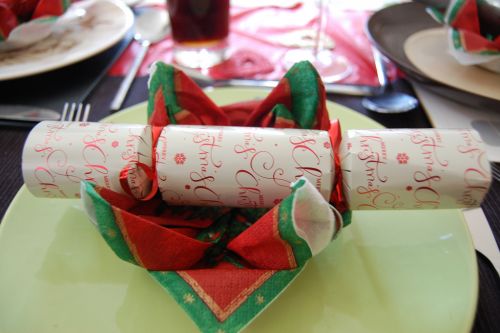 Christmas cracker
Christmas cracker
The cracker is shared by two people. Each of them pulls one side of it. During splitting small bang sound is created because of friction on the cardboard tube which was previously impregnated with a special chemical substance. There are different rules of who gets the content of tube. Sometimes it is the person whose part of cracker is bigger.
In the Netherlands many of Christmas traditions are related to Saint Nicholas or "Sinter Klaas". He wears bishop's clothes, miter and rides a white horse. It is believed that he is accompanied by "Black Peter". His face is covered in soot. He has horns and red eyes. He rides a mule. When Dutch kids meet him they are told that Black Peter was a devil who became a servant of Saint Nicholas. Black Peter wears Spanish medieval clothes as a reminder to Spanish rule over the Netherlands in the 16th century.
According to Dutch tradition Saint Nicholas and Black Peter arrive on the 5th of December. They enter homes through chimneys. After that they leave presents for kids. Kids fill their shoes with straw, carrots or sugar to attract the horse and mule ridden by the two characters. Big Saint Nicholas parties are held all over the Netherlands on 6th December. One of the biggest is the one held in Amsterdam.
In the region of Twente, located in the east of country, people have an interesting Advent tradition. They use young tree to made big horns. When blown they create deep sound. They announce the birth of Christ and scare away evil spirits. People in the Netherlands have a bit unusual Christmas biscuits. They are called "Letterbanket" or just "Banket". This letter-shaped biscuits are made with almonds. Yet another Christmas delicacy in the Netherlands is made with almonds. It is called "Kerstkrans" or "Dutch Christmas Ring".
Saint Nicholas visits kids in Belgium too. In Wallonia he visits them not once, but twice! First, he arrives on the 4th December to check their behaviour. He returns on the 6th December with presents for those who are good. Bad kids get a twig. To attract Saint Nicholas' horse kids put straw, carrots and water in a small basket or shoe which is placed close to the front door of each home. Saint Nicholas arrives to Flanders too. He is there on the 6th December. Belgium has a centuries-old tradition of nativity plays. They are organized all over the country. One of famous Christmas delicacies in Flanders is "koffiekoek" or "coffee cake". At Christmas breakfast in Wallonia people eat "cougnou" or "cougnolle." This sweet bread has shape similar to baby Jesus.
Saint Nicholas or "Klees'chen" is a popular guy in Luxemburg too. Local legend about him is rather unusual. According to this legend with God's help he managed to bring back to life three kids killed by a butcher. He brings presents to good kids. Bad kids are visited by Black Peter or "Husicker". This old man wearing black clothes is carrying a basket full of twigs, sticks and coal. They are his "presents" to them. If a kid is really bad, Black Peter will take him or her throughout village for everyone to see him or her.
Christmas market in the German city of Nuremberg is known as Christkindlesmarkt. It is famous for the Zwetschgenmännla or Prune people. These lovely figurines appeared here at the beginning of the 19th century. Each figurine is made of fruit. Dried prunes and some wire are used for arms and legs. The body is made of dried figs and the head is a walnut.
The Prune people can be male or female. They are traditionally dressed as chimney sweepers. But figurines dressed as other professions exist too. There is a local belief that the Prune people bring money and happiness to whoever owns them.
There is an old German legend stating that only those of pure heart can see that on Christmas Eve rivers turn to wine, animals can speak, tree blossoms bear fruit, mountains open showing large quantities of gems and bell ringing can be heard from the bottom of the sea. Christmas tree, as we know it today, has its origin in Germany. Germans have several legends about it. As to the first one, Christ Child got lost in the forest. Woodcutter and his wife found him and gave him some food and shelter. To thank them for their help Christ Child broke off a branch off an evergreen and told them that each year, on Christmas, it would bear lot of fruit. Later it turned out that these fruit were golden apples and silver nuts.
In the 16th century during Christmas people of Alsace (Elsass) region, which was then part of Germany, often brought different evergreen trees to their homes. This tradition is probably even older and has Pagan origin.
The next legend is of Protestant origin. One evening Martin Luther was returning home. He was passing through forest. It was a starry night. Firt trees looked especially nice. So, he cut off one and bring it to his home. Martin Luther decorated the tree with some candle tapers as sort of symbols that should remind people of the star that appear above the manger where Christ was born. Martin Luther is also the "author" of German belief that Christmas presents are brought by the Christkindl or “Christ Child”. It is believed that Christkindl is a young girl wearing white clothes and golden crown.
Sauerland is a hilly area in the southeast of North Rhine-Westphalia. It is well known that on the 21st December daylight is the shortest of year. On this day locals celebrate Saint Thomas' Day. There is a tradition that whoever wakes up late or does not arrive to work in time is called "Thomas Donkey". These people get a cardboard donkey and everyone laughs at them. On Saint Thomas Day people of Sauerland prepare currant buns called "Thomasplitzchen".
Germans have a funny name for Christmas Eve. They call it "Dickbauch" or "fat stomach". Traditionally all those do not eat a lot during Christmas Eve will be haunted by evil spirits during whole night. I guess that is why Christmas tables in Germany are full of delicacies like for example "Christstollen" (bread with nuts, raisins, citron and dried fruit), "Lebkuchen" or "Pfefferkuchen".
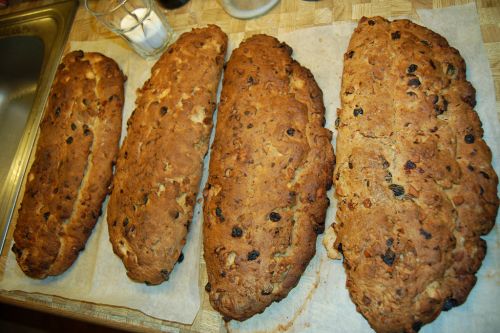 Christstollen
Christstollen
After attending a Midnight Mass people in Austria return to their homes where Christmas dinner is served. Typical dishes served are "Gebackener Karpfen" (fried carp), Christmas cookies called "Weihnachtsbaeckerei" and different cakes like for example famous "Sachertorte" made of chocolate and apricot jam.
One of the most famous Christmas carols "Silent night" is originally from Austria. The lyrics of this song were written by the Austrian priest Josef Mohr and the melody was composed by the Austrian headmaster Franz Xaver Gruber. The song was performed on the Christmas Eve of 1818 in the Saint Nicholas church located in a small town of Oberndorf bei Salzburg. The mentioned church does not exist anymore. On the same places there is a chapel called the "Stille-Nacht-Gedächtniskapelle" (Silent Night Memorial Chapel). Next to this chapel there is a small museum dedicated to this famous carol.
Let's finish our Christmas journey across Europe in Switzerland. On the 6th December in Swiss town of Küssnacht, located in kanton Schwyz, there is a traditional event called "Küssnachter Klausjagen". Every year it attracts huge crowd of more than 20,000 people. In this fascinating procession some 200 people carry "Iffeln", which are huge lanterns in the shape of bishop's mitre.
They are followed by Saint Nicholas and his assitants "Schmutzlis" wearing dark clothes. Finally there are more than 1,000 "Klausjäger" or "Klaus Chasers" wearing white t-shirts and red ties. They use big cow bells, brass instruments and whips to create huge noise.
In Zurich and other big Swiss cities kids can enjoy in "marlitram" or "fairytale tram". Kids are entertained by Saint Nicholas, Christmas angels tell them stories. Everybody is singing. Kids eat all kind of biscuits and other sweets.
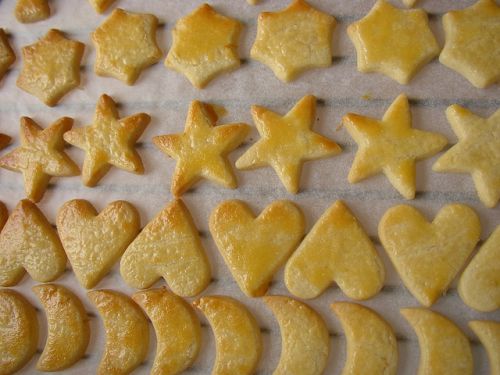 Mailänderli
Mailänderli
Like everywhere in the world people enjoy numerous delicacies. Some of them are "Mailänderli" (Christmas butter biscuits), "Zimsterne" (Cinnamon stars) and "Spitzbuben" (Jam biscuits). During Christmas season in Switzerland there are groups of people dressed as the Magi who walk down streets of town and villages singing Christmas carols. They are called the Star Singers or Sternsingers.